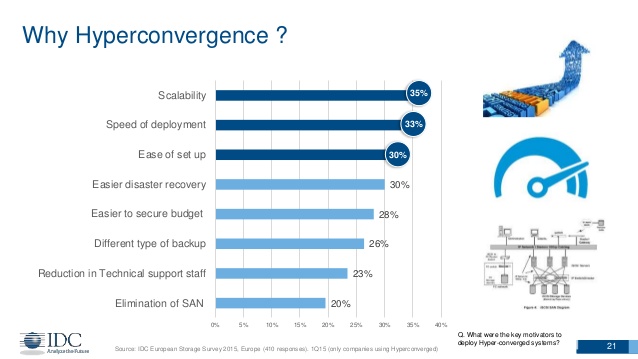For many people, when they think of the beginning of server virtualization,
VMware generally comes to mind. But the fact is, server virtualization actually started in the early 1960’s and was pioneered by companies like
General Electric (GE), Bell Labs, and
IBM.
Virtualization promised to change the landscape of computing. It actually revolutionized how we look at
compute resources by abstracting software from its underlying hardware. Compute resources are now pooled for improved efficiency and deployment and management of physical resources have become much more manageable.
As with any technological improvement, virtualization created new opportunities and enhancements. As server virtualization took hold, new technologies emerged from the developed of integrated systems to converged and hyper-converged systems.
Hyper-converged infrastructure didn’t even exist as a concept two or three years ago. Today, it is one of the fastest-growing methods for deploying IT in the data center, as IT departments look for new ways to adjust to the rapidly changes demands of the business.
Gartner expects Hyper-convergence to go from zero in 2012 to a $5 billion market by 2019, becoming the category leader by revenue in pre-integrated full-stack infrastructure products. The category also includes reference architectures, integrated infrastructure, and integrated stacks.*
So what is hyper-convergence? What problems does it promise to address?
The next step in the evolution of IT architectures brings together all the advantages of converged infrastructure, virtualization, and software-defined storage technologies.
Everything you need - including servers, storage, virtualization software, networking, and management - is fully integrated and packaged together into a single, yet highly available, appliance. Therefore, hyper-converged systems allow integrated technologies to be managed as a single system through a common tool set.
The hyper-convergence concept is to abstract other layers of infrastructure to gain simplicity and elasticity. By leveraging software-defined networking (SDN), it capitalizes on the benefits of standardization to network virtualization and reduces costs in hardware and management layers. SDN with open networking standards also promises cross-platform compatibility.
Thus, virtual SAN promises to abstract storage infrastructure from management dependencies.
By bringing compute, hypervisor I/O control, and storage entities together, hyper-convergence lets administrators manage pools of compute resources, disk assignments for hosts and virtual machines, and network underlay configuration from a single unified management interface.
Hyper-converged systems offer benefits such as faster deployments, the ability to quickly expand capacity, automated deployment of most infrastructure components, and reduced external dependencies.

Infrastructure-in-a-box
The "infrastructure in a box" concept of hyper-converged systems can be particularly attractive to small and medium-sized businesses (SMBs because all the elements of the virtual environment can be managed from one place therefore making it easier for small IT shops). To expand, you simply need to add nodes.
"Hyper-convergence is the latest step in the now multiyear pursuit of infrastructure that is flexible and simpler to manage, or a centralized approach to 'tidying up' data center infrastructure." Andrew Butler, Gartner Analyst **
At
Sentia, we see a future full of possibilities to address the myriad of IT challenges. New technologies hold the promise of creating new opportunities to enable CIOs to reach their objectives while reducing costs.
To learn more, join this on-demand webcast: Hyper-converged Infrastructure for Demanding Enterprise WorkloadsTo read the Hyperconverged Infrastructure for Dummies eBook,
download your complimentary copy here:
If you’d like to further explore the possibilities of how hyper-convergence could benefit your organization, please
drop us a line or contact us via
Twitter,
LinkedIn or
Facebook to get the conversation started
Enjoy the reading!
Sources:*Gartner Press Release, May 5 2016, http://www.gartner.com/newsroom/id/3308017
** Why Hyperconverges Infrastructure is So Hot, December 10 2015
http://www.datacenterknowledge.com/archives/2015/12/10/why-hyperconverged-infrastructure-is-so-hot/